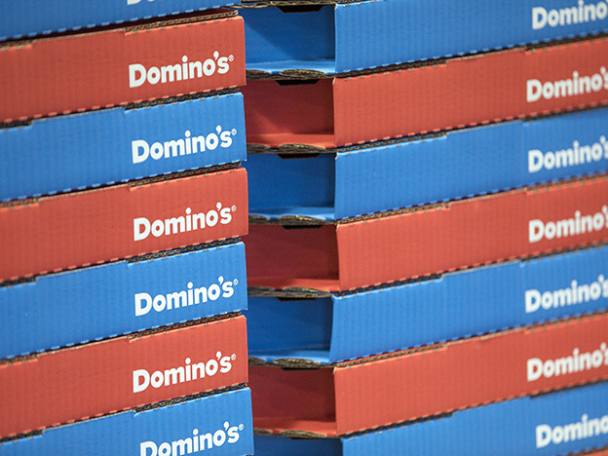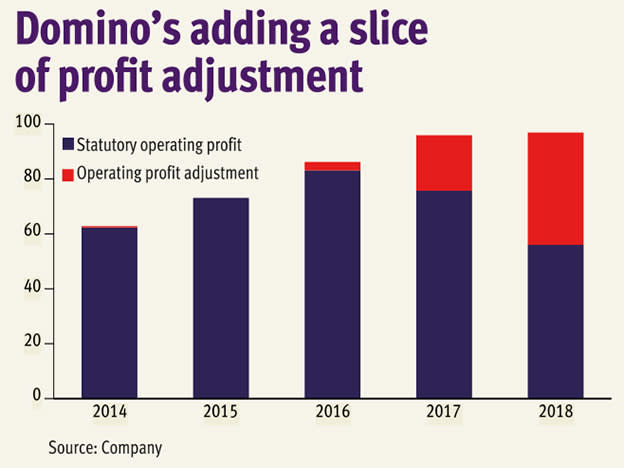Last month, Domino’s Pizza (DOM) announced the retirement of chief executive David Wild. Mr Wild, who has pledged to stay on until a successor is in place, will be handing over the reins of a former stock market darling that is now grappling with declining profit quality, rising debt and slowing growth.
Well-known brand
Rising sales
Dispute with franchisees
Rising adjustments
International losses
CEO uncertainty
A key issue the new boss will face is a well-publicised struggle with franchisees, which has caused new UK store openings to stall.The situation is described as “complex”, with a resolution not expected until sometime in 2020. Franchisees appear to be in a powerful position, which is part-explained by the fact that the two largest franchisees account for nearly two-fifths of UK stores, with the third-largest accounting for 7 per cent.
Domino's wants to grow UK stores from 1,103 to 1,600, but there are fears about "cannibalisation", with catchment areas having already shrunk from 24,000 addresses to around 17,000 in the five years to the end of 2018. This comes against a backdrop of rising competition from food delivery apps, although Domino's is seeking to tap into this trend by offering delivery through Just Eat (JE.). Management has said new store openings for the 2019 financial year will be “materially lower” than the 58 achieved in 2018.
Relying on franchisees to open and operate stores has traditionally kept Domino's own capital needs low. Domino’s revenues, meanwhile, come from selling ingredients to franchisees and charging a royalty fee. However, in recent years the group has had to sink more capital into its business as it invests in its supply chain, increases the number of corporate (own-run) stores, and seeds its overseas operations. This has been accompanied by an increase in share buybacks as the group's operational performance and share price have flagged. The effect on the balance sheet has been marked, with the group moving from a £40m net cash at the end of 2015 to £238m net debt at the end of June 2019.
The rise in capital employed by Domino's operation has led to a deterioration in the group's famously high return on average capital employed (ROCE), which many regard as a key indicator of business quality. Based on SharePad data, ROCE has fallen from almost 70 per cent in 2015 to less than 30 per cent in 2018. However, a bigger issue regarding profit quality is the increased adjustments being made to underlying profits (see chart below). Much of this reflects adjustments related to the international business, which reported first-half operating losses of £6.4m compared with £4.1m for 2018 as a whole.
| Domino's Pizza (DOM) | |||||
| ORD PRICE: | 250.3p | MARKET VALUE: | £1.2bn | ||
| TOUCH: | 250-251.2 | 12-MONTH HIGH: | 301p | LOW: | 219p |
| FORWARD DIVIDEND YIELD: | 4% | FORWARD PE RATIO: | 17 | ||
| NET ASSET VALUE: | * | NET DEBT: | £239m | ||
| Year to 30 Dec | Turnover (£m) | Pre-tax profit (£m)** | Earnings per share (p)** | Dividend per share (p) | |
| 2016 | 361 | 85.7 | 13.8 | 8.0 | |
| 2017 | 467 | 94.4 | 15.7 | 9.0 | |
| 2018 | 534 | 93.4 | 16.1 | 9.5 | |
| 2019** | 604 | 86.8 | 14.9 | 9.9 | |
| 2020** | 647 | 91.5 | 15.0 | 10.0 | |
| % change | +7 | +5 | +1 | +1 | |
| Normal market size: | |||||
| Beta: | 1.48 | ||||
| *Negative shareholders' funds | |||||
| **Numis forecasts, adjusted EPS and PTP figures | |||||












